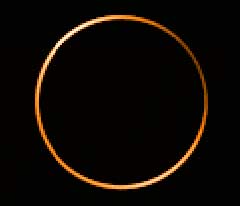
The infrared array camera "SupIRCam" is offline due to a leak in its coolant pipes. Tests show in its current state the camera would lose all of its coolant within a few hours if filled again. Work is underway on site to identify the location of the leak and to effect a remedy.
Two new instruments were fitted to the LT and saw first light on 17th November: the new GRB optical polarimeter "RINGO", and the "Meaburn Spectrograph". They are both specialist, non-common-user instruments, and have yet to be robotically commissioned, i.e. fully integrated into the autonomous system.
RINGORINGO uses a novel design first used by David Clarke (Glasgow) where a polaroid is rotated rapidly at 500rpm in the beam of the telescope, creating a time variable signal if the source is polarized. This time variable signal is converted into a spatial signal by a small angle wedge prism rotating with the polaroid. This signal is recorded on a thermoelectrically cooled CCD. The end result is that each source is imaged as a small ring, with the polarization signal mapped out twice around its circumference.
This image shows a 30 second exposure of a polarization standard (BD +64 106), with the polarization signal clearly present. RINGO will mainly be used for GRB followup in the first few minutes of the burst, where certain models predict a strong polarization signal.
Meaburn Spectrograph (previously the "prototype spectrograph")The second instrument is the prototype spectrograph developed in collaboration with John Meaburn and Dan Harman when they were at the University of Manchester. This is a fibre-bundle-fed spectrograph, with a resolution of ~5 Angstroms (more details). First light spectra were taken of Capella and BD +47 183, displayed below. Note that all the features in the spectra are genuine features, as would be expected for such bright sources.
|
|
|
||
|
|
First light spectrum of Capella. This is the first spectroscopic data taken with the LT. |
|
Ten second exposure showing H-alpha line emission (EW = -32.3 Angstroms) from the Be star +47 183. (click for larger picture) |
Further commissioning of both of these instruments is now underway on site, with the aim of characterization of instrumental signatures in the data and sensitivity calibration. After that the next big task will be their integration into the automated operation of the telescope. This will take place over the next couple of months, and we will keep everyone updated as to progress.